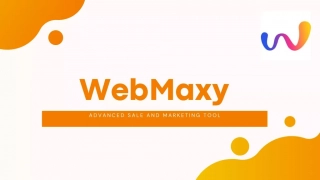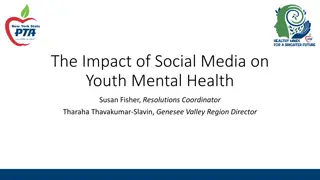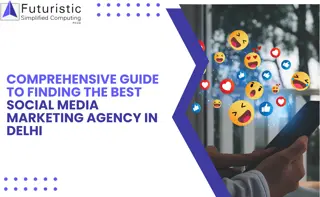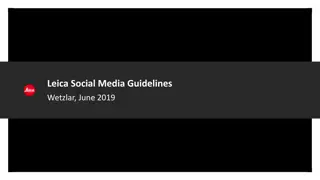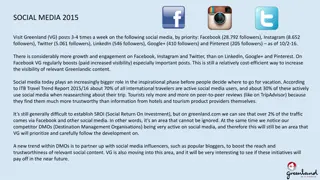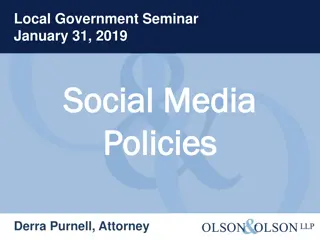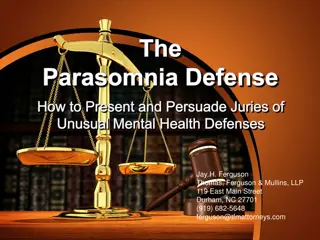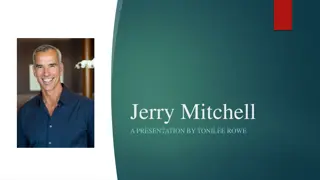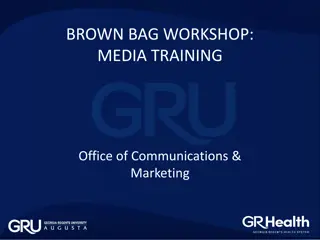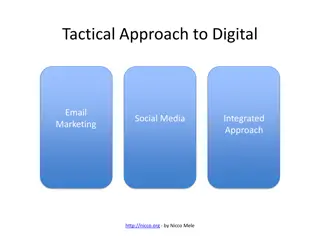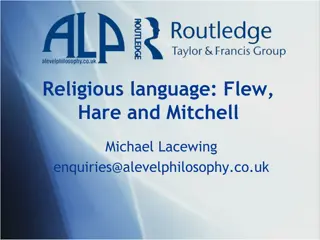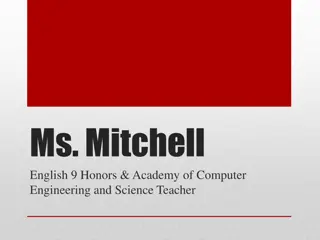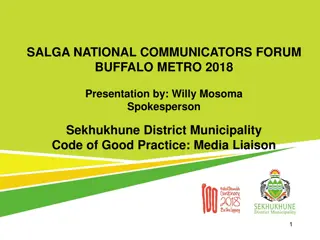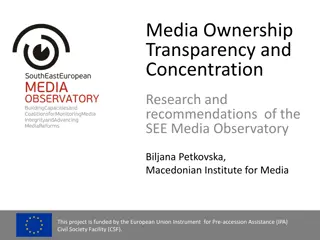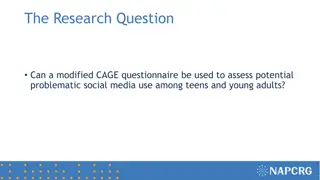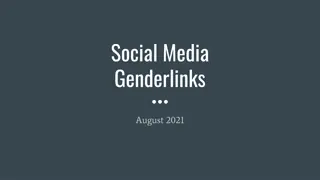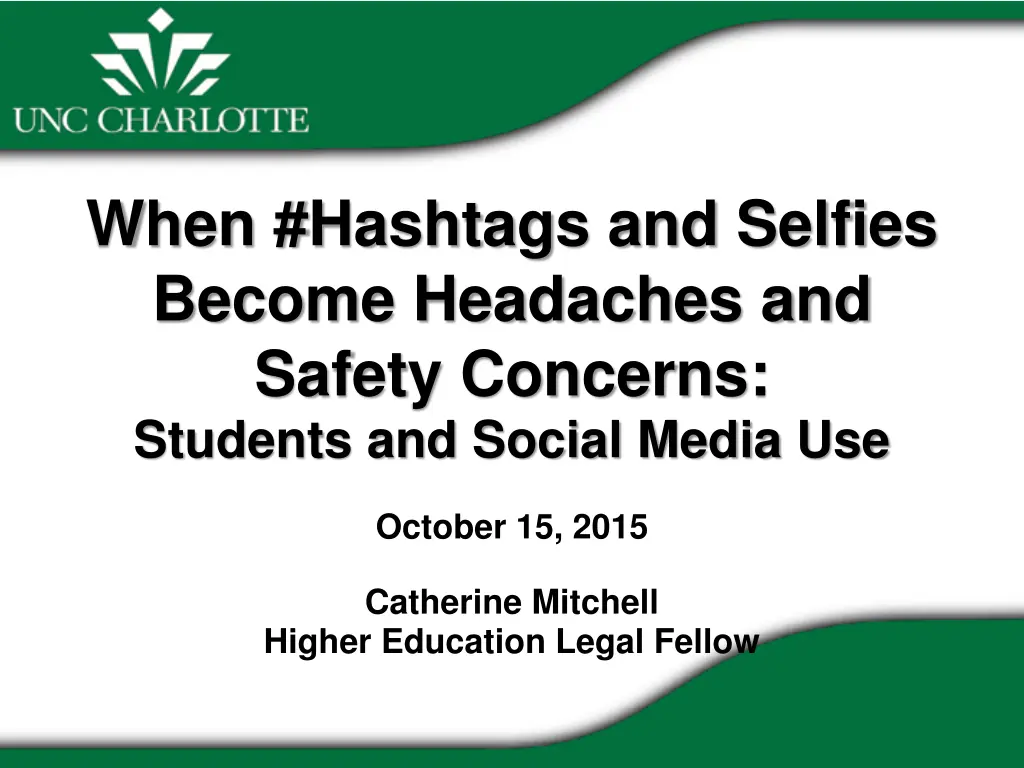
Students and Social Media Challenges: A Legal Perspective
Explore the implications of social media use on college campuses, focusing on constitutional issues, privacy rights, electronic harassment, and best practices for protecting students. Dive into the special characteristics of social media, common platforms, and student speech cases like Tinker v. Des Moines Independent Cmmty School District.
Download Presentation

Please find below an Image/Link to download the presentation.
The content on the website is provided AS IS for your information and personal use only. It may not be sold, licensed, or shared on other websites without obtaining consent from the author. If you encounter any issues during the download, it is possible that the publisher has removed the file from their server.
You are allowed to download the files provided on this website for personal or commercial use, subject to the condition that they are used lawfully. All files are the property of their respective owners.
The content on the website is provided AS IS for your information and personal use only. It may not be sold, licensed, or shared on other websites without obtaining consent from the author.
E N D
Presentation Transcript
When #Hashtags and Selfies Become Headaches and Safety Concerns: Students and Social Media Use October 15, 2015 Catherine Mitchell Higher Education Legal Fellow
Overview Social media use on college campuses Issues to consider o Constitutional Issues Free speech Privacy rights o Protecting students Electronic harassment and cyberbullying Other safety issues Monitoring o Student-athletes and social media Best practices
Social Media Uses and Trends General social interaction with friends Share videos, photos, multimedia content Express concerns, thoughts, ideas, stories Gossip sites Promote events Retrieve and provide information
Common Social Media Platforms Facebook Instagram Snapchat Twitter YouTube LinkedIn Yik Yak Burnbook Whisper Flickr Blogs
Special Characteristics of Social Media Instant and broad-reaching Information can go viral o Immediacy o Everyone is connected o Popularity Private accounts Anonymity o Can hide behind usernames o Grounds for controversial topics and discussions Difficult to address Effects on public relations
Things to Consider Constitutional Rights o Free expression o Privacy rights Protection of Students o Cyberbullying and Harassment o Monitoring Pros and Cons o Educating Students
Old issue, new mechanisms, continued concerns Speech on college campuses not a new issue Social media provides more ways, easier access, new challenges Supreme Court has not taken up this matter
Student Speech Cases Tinker v. Des Moines Independent Cmmty School District (1969) May limit or discipline student expression if school officials reasonably conclude that expression will materially and substantially disrupt the work and discipline of the school Healy v. James (1972) Colleges may prohibit students associational activities that would infringe reasonable campus rules, interrupt classes, or substantially interfere with the opportunity of students to obtain an education o substantial and material disruption test may apply to college s efforts to regulate or discipline student speech BUT o College has less leeway in regulating or disciplining such speech than secondary schools
Hazelwood School District v. Kuhlmeier (1988) Court held that officials can regulate the style and content of school- sponsored student speech in ways that are reasonably related to legitimate pedagogical concerns But court seems to point to Tinker for disciplining online student speech Morse v. Frederick (2007) Bong hits for Jesus case schools may take steps to safeguard those entrusted to their care from speech that can reasonably be regarded as encouraging illegal drug use But language likely intended for secondary school settings
Christian Legal Society v. Martinez (2010) US Supreme Court explained that courts are final arbiter of question whether public university has exceeded constitutional constraints and courts owe no deference to universities in considering that question BUT determinations of what constitutes sound educational policy fall within discretion of school administrators and educators January 2013 US Supreme Court declined to hear several Internet speech cases
Free Speech Analysis Is this speech or conduct? Is it protected speech? Where does the speech occur? On campus? Off-campus? Nexus to campus? Is it parody? Has it created a material, substantial disruption? Does it trigger other obligations? Ex: Title IX, Campus SaVE, Clery, etc.
Speech or Conduct? Are we focusing on the speech or the actual conduct of the student? Requa v. Kent School District (W.D. Wash. 2007) Video of teacher posted to YouTube and MySpace Focus on violations of Student Code of Conduct
Code of Student Responsibility Threats Fear Harassment Intimidation Hazing Stalking Disruption of normal university activities Unauthorized electronic recording Violation of computer use policies etc.
Is it protected speech? Unprotected: True threats Fighting words Speech that incites imminent lawless action Child pornography Unlawful harassment Defamation
Is it protected speech? Public institution May control access to and use of university property Policy/restrictions must comport with First Amendment requirements o Viewpoint-neutral o Reasonable time, place, and manner restrictions o Overbroad or vague?
Is it protected speech? Forum analysis: o Have we created a forum? o University sponsored website/account/etc. o Types of forums o Public o Nonpublic o Designated or limited public o Type of forum created influences the control university can exercise over speech o Forum rules apply to physical and virtual spaces
Where Did the Speech Occur? On-Campus? Off-Campus? *often with social media/internet speech* Much more difficult to decide U.S. Supreme Court has not given clear guidance o Denied cert in three cases in January 2013 o Split in circuits
Off-Campus Kowalski v. Berkeley County Schools (4th Circ. 2012) sufficiently connected to the school environment to trigger Tinker s substantial disruption analysis Court rejected the importance of the metaphysical question of where [the student s] speech occurred when she used the Internet as the medium. Posted at home but knew it would be published beyond her home and reasonably expected to reach school or impact school environment DJM v. Hannibal Public School District (8th Circ. 2011) Off-campus application of Tinker is appropriate where it is reasonably foreseeable that off-campus threats create a risk of substantial disruption within the school environment
Layshock v. Hermitage School District (3rd Circ. 2011) District court found it created curiosity not a substantial disruption Third Circuit upheld Court found that school could not regulate the expressive conduct which occurred outside the school context
Is it parody? Speech is so outrageous that no reasonable person would take it seriously J.S. v. Blue Mountain School District (3rd Circ. 2011)
Common Standard for Social Media Speech Tinker School may prohibit and discipline on-campus student speech that could materially and substantially interfere with the requirements of appropriate discipline in the operation of the school This has been applied to college/university setting as well
Is there a material and substantial disruption? Tatro v. University of Minnesota (Minn. Ct. App. 2012) Threat to stab someone, death list, concern from university community, police investigation, integrity of program Impact of speech on those who learned of it Integrity of academic program o Academic program rules ok to regulate student speech on social media but must be narrowly tailored and directly related to established professional conduct standards Murakowski v. University of Delaware (D. Del. 2008) [a]lthough complete chaos is not required, something more than distraction or discomfiture created by the speech is needed.
Anonymous Speech Gossip sites o Yik Yak, Whisper, Burnbook, Juicy Campus Platform for hate speech, disruptive speech, etc. Often online, off-campus Difficult to identify o Geolocation o Work with social media sites
Privacy Rights Fourth Amendment o Reasonable expectation of privacy Electronic Communication Privacy Act o Prevents an entity from intentionally accessing without authorization and thereby obtaining an electronic communication from an electronic communication service while it is in storage o Voluntary nature of some activities may allow authorization for school to view communication over social media (student-athletes, student organizations, etc.)
PROTECTING OUR STUDENTS
Cyberbullying & Electronic Harassment Cyberbullying What is it? Growing problem linked to suicides on campuses Other Electronic Harassment Title IX, Campus SaVE, VAWA obligations Cyberstalking Obligation to respond to student harassment Severe and pervasive? Do we have substantial control? Do we know or reasonably should know about it? Potential problems when addressing these issues: o Anonymous posts o Online, off-campus speech
Other Safety Concerns Threats to the university community Hate speech Concerning behavior Suicide prevention
Monitoring Advantages to proactive monitoring Identify cyberbullying, electronic harassment, concerning behavior Know students interests, concerns, etc. Disadvantages to proactive monitoring Creates liability for university o Assumed a duty and may face liability if fail to meet that duty Failure to monitor properly Failure to act Infringing on rights of students Electronic Communications Privacy Act
Liability for Monitoring Failure to monitor o Create a duty miss something liability Active monitoring o Become aware of threat and fail to act o Stored Communications Act Question of implied consent Public information? Special circumstances o Learn of something should monitor/look into it o Policy? o Particular groups? o Always be mindful of assumption of a duty
University Response Look to Code of Student Responsbility Look to discrimination laws and policies o Be mindful of Title IX and Campus SaVE obligations Look to University Policies on use of the computer network, university computers, etc. Contact law enforcement Seek assistance from social media services to remove offensive posts, retrieve information, etc.
University Response Educate our students!! Posts may be public Posts are permanent Posts may spread quickly Policies on network and computer use Effects of cyberbullying/electronic harassment on the victim/others and potential criminal action Potential discipline at school-level
Educating Students on Safe Practices Threats: Identity theft Online stalking GPS tracking Identifying patterns Criminals monitoring accounts A few Do s and Don ts o Don t post status updates on your location o Do turn off location services o Don t share that you are leaving town o Do keep profile private o Don t accept friend requests from people you don t know
STUDENT-ATHLETES AND SOCIAL MEDIA
Student-athletes Things to consider: More publicity, more followers NCAA rules and recommendations o UNC-Chapel Hill--Report from Committee on Infractions Team unity/chemistry Constitutional issues Fans and boosters
Student-Athletes Privilege, not a right argument o But argument that athletes don t lose all constitutional rights when step on field/court o Should not be unreasonably broad Courts have recognized a difference between speech in the classroom and speech on playing field o Have allowed restriction to prevent substantially negative effect on team o Can consider team unity/chemistry
Social Media Bans Prior restraint Governmental restriction on speech or publication before its actual expression Violates First Amendment unless speech is obscene, defamatory, or creates clear and present danger to society Government has burden of providing sufficient justification for restraint: o Must show that ban: Does not allocate overbroad discretion to government Not content-based Narrowly tailored to serve significant government interest Offers reasonable alternatives for communication
Monitoring Student-Athletes Social Media Examples of ways schools monitor: o Third party Varsity Monitor, etc. o Student-athletes must accept coach s friend request o Policy on social media use what can and cannot say Similar considerations as monitoring general student population o Constitutional concerns o Create a duty
OTHER CONSIDERATIONS
Use of Social Media in the Classroom Classroom space made more public Students can post photos, live tweet, periscope, etc. FERPA concerns Create a duty and obligation to report Advantages as well more student interaction, easier to communicate, etc.
Social Media Use by Employees Free expression rights of employees Kansas University example Academic freedom
Proactive Steps Educate students (and faculty and staff) o Best practices o Safety issues o Code violations o Criminal action o Liability o NCAA rules If monitor, do so effectively and be mindful of assumption of duty Positive reinforcement for social media use
Positive Effects of Social Media Student interaction Publicity Share stories Efficient Cost effective
QUESTIONS, COMMENTS, DISCUSSION #NinerNation

